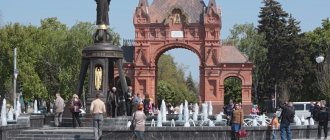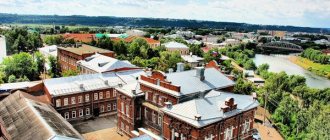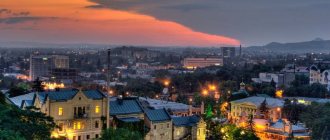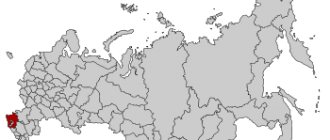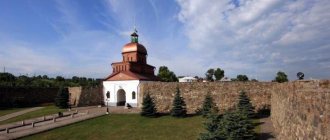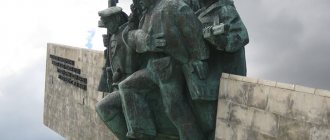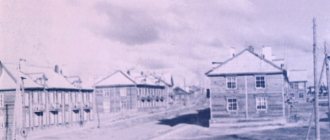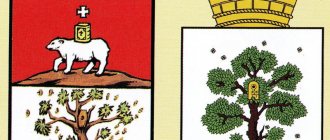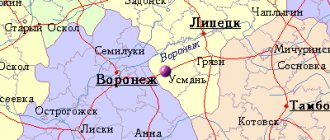Krasnodar is the largest economic and cultural center of the Southern Federal District. At one time it was a leader in the Russian ranking of cities with growing business activity. Forbes magazine has recognized the city three times as “The Best City in Russia for Doing Business.” All this could not but affect the increase in the attractiveness of Krasnodar. The city has many interesting places. There is a large selection of excursions.
Krasnodar
Within walking distance from the sea
Krasnodar is the capital of the Krasnodar region. It is located on the banks of the Kuban River. The Black Sea coast is only 120 kilometers from here, and the Sea of Azov is 140 kilometers. From Moscow to the Kuban capital – 1300 kilometers. The cities are connected by the M4 Don highway. Unofficially, Krasnodar is called the “capital of the South of Russia”. Unlike many other regional centers in the country, its population is growing. Recently, the number of residents, including its suburbs, exceeded the million mark.
Krasnodar is a very green city
From a geographical point of view, the city is located on the Kuban-Azov lowland. This is the very south of the East European Plain. The terrain is flat, with a slight slope in the northwest direction. The height above sea level does not exceed 32 meters. The Kuban River goes around the city from the south, forming bizarre bends. Not everyone knows that Krasnodar is located in a seismically active zone. Earthquakes up to magnitude 5 have occurred here.
Krasnodar is characterized by long, hot summers and short, warm winters. Spring starts in the second half of February. Summer comes at the beginning of May and lasts until the end of September. At the height of summer, the average temperature is +24 degrees, but sometimes the thermometer reaches +40 degrees. There are practically no negative temperatures, so there is no snow in winter. The most precipitation falls in November and December, the least in August. December is considered the rainy season.
Shopping and souvenirs
Krasnodar is a city founded by the Cossacks, and therefore the best way to betray its spirit is to bring from here real Cossack sabers, burkas, hats, or, at worst, just clay figurines of Cossacks.
If your loved ones appreciate gifts that you can taste, then be sure to bring them local sunflower seeds - they are tasty and large here, walnuts or jam made from them, and jam made from local dogwood berries also has an incomparable taste. Smoked Adyghe cheese is also considered a real delicacy, but keep in mind that its shelf life is extremely short, so you shouldn’t buy it if it takes you several days to get home.
In addition, from Krasnodar, as well as from Sochi, they bring chestnut honey, tinctures and balms from mountain herbs, wine and fish (roach and shamaika, which are caught in the Sea of Azov, are especially valued).
Catherine's Gift
On the territory of the City Garden, archaeologists discovered the remains of a large settlement. More than 2 thousand years ago, the Meotian tribes lived in these places. According to one version, it was a colony of Indians who moved to the Black Sea coast. Later, during the Bosporan Kingdom, a large city was built on the banks of the Kuban, surrounded by fortified walls. Now this place is the village of Elizavetinskaya.
Monument to Catherine II
Krasnodar was officially founded in 1793. Then Empress Catherine II, by decree, transferred local lands to the Cossacks for eternal use. It is clear why the Cossack settlement was called Yekaterinodar. A year later, active planned land development began. First of all, the Cossacks built a fortress on the banks of the Karasun River. Civil development moved away from it. According to the documents, in the first year “9 houses, 75 huts, 154 dugouts” were built.
Ekaterinodar found itself at the crossroads of important roads, so it developed rapidly. Already in 1860, it became one of the major commercial and industrial centers of the empire. An iron foundry and metal processing plants were built here. The impetus was given by Maikop oil, which was processed in Yekaterinodar. The city suffered greatly during the Civil War. For some time it was the White Guard capital of the South of Russia. After the change of power, it was renamed Krasnodar. This happened in 1920.
History of the emergence of the city of Krasnodar
Tsarina Catherine II, having thought about protecting the southern borders of our country, thought that it would be nice to have people living here on a permanent basis, capable of defending these places as if they were their own relatives. Then she understood that if she gathered all the Cossacks from Russia and gave them lands in the south of the country, they would be very grateful. And what’s more, they will defend their lands and borders of the Motherland completely free of charge and selflessly. She was a very wise queen, so she did so. Essentially killing two birds with one stone.
Catherine the Great, portrait by an unknown artist
For the curious
Guests of the city are offered about twenty excursions on a wide variety of topics. You should start with the sightseeing bus and walking route “Meet the City of Krasnodar”. The program includes all the main attractions not only in the historical center, but also in new buildings.
The excursion “Industrial City of Krasnodar” allows you to visit the largest enterprises “Ochakovo”, “Klaas”, “Saturn” and “Alexandria”. It is impossible to get there on your own. At the Ochakov plant, tourists visit the Kvasovar's Hut, a reconstruction of the 18th century. After completing the excursion, guests are treated to kvass, juices and lemonade.
Guests of the city are offered about 20 excursions on a wide variety of topics.
The two-hour route “Three Centuries of the All Saints Cemetery” is dedicated to famous people of the city who are buried in the oldest city cemetery. This is, for example, the writer N.N. Kanivetsky, cornet Korzhevsky, ensign Rumyantsev, podesaul Aseev and others.
In summer, it is worth taking the “Walk through the Botanical Garden” excursion. The southern climate allows you to grow a huge number of plants outdoors. There are 20 thousand trees and 200 thousand shrubs growing in the garden! But the route “Flowers at the Obelisks” is dedicated not to flowers at all, but to monuments from the period of the Great Patriotic War.
Gourmets will certainly enjoy the Krasnodar-Gastronomic route, which includes visits to three restaurants. At the Stan restaurant-museum, tourists are introduced to the ritual of hospitality. At Dukhan they serve Kuban dishes. The Pech restaurant teaches you how to cook traditional dishes. Another “delicious” gastrotour is called “Kuban Delight”. Participants are invited to guess the ingredients of borscht at the BorschBerry restaurant, take a master class on cooking jellied rabbit and taste five types of Kuban liqueurs.
There are specialized excursions dedicated to any one street. For example, in the company of a guide you can walk along Aleksandrovsky Boulevard, Krasnaya, Krasnoarmeyskaya and Rashpilevskaya streets. The maximum number of attractions is concentrated on them. During the “Path of Health” excursion, you have the opportunity to visit Krasnodar health resorts, try a herbal cocktail and healing water.
Modern architecture of Krasnodar
There are a number of thematic routes. The name of the tour “Architectural Krasnodar” speaks for itself. The Domes over the City tour includes visits to six main temples. The “Theater Leaflet” route program involves getting to know not only theaters, but also theater museums. There is an opportunity to visit the Krasnodar Hippodrome in an organized manner. In this case, you will even be able to visit the stables. For lovers of active recreation, bicycle tours around the city are offered.
Coat of arms of the city of Krasnodar history of the coat of arms
Exactly the same story happened with the coat of arms of the city of Krasnodar. In 1841, the design of the coat of arms was entrusted to the captain Ivan Denisievich Chernik. The coat of arms of Yekaterinodar was approved by Emperor Nicholas I on September 3, 1849. Look, what an irony, the simple coat of arms of the city was approved for 8 years.
MUST READ About traffic jams and traffic in Krasnodar
In 1867, Ekaterinodar was transferred to a “general civil system”, i.e. the city coat of arms was approved, a city duma was elected, and a city mayor was appointed.
Only the coat of arms was first created for the city of Ekaterinodar, then Soviet power came and the coat of arms was changed to their own. The only difference in the history with the coat of arms and the name of the city is that the coat of arms today has been returned to the one that was under the king, and the name of the city remained precisely from the Reds.
coat of arms of the city of Krasnodar used during Soviet rule, coat of arms of the city of Krasnodar, use with or without a crown is acceptable
Main attractions
There are eleven theatres, ten concert halls and twelve museums in Krasnodar. People have lived on the territory of what is now the Krasnodar Territory since ancient times. The climate here is very good and the nature is picturesque. You can get acquainted with the history of the region at the Krasnodar Historical and Archaeological Museum-Reserve. It bears the name of its founder, military sergeant major Evgeny Felitsyn. The museum opened its doors to visitors 140 years ago!
Contemporaries called Felitsyn “the encyclopedia of the Caucasus.” He spent his small salary on purchasing exhibits. He managed to collect the best collection of Polovtsian stone sculptures in the world. He collected them throughout the Kuban region. In the first year alone, the museum exhibition was replenished with 276 archaeological objects.
Monument to Russian-Circassian friendship
The museum currently has nine permanent exhibitions. The exhibition “The Ancient Past of Kuban” is of greatest interest. Here are collected things created by man over five thousand years! The decorations made by the Scythians are especially impressive. There are other rarities. For example, the Sea Kaleidoscope exhibition features a stuffed lobster and a whale skeleton. What's surprising here? Both exhibits appeared in the museum in 1880!
The name of the collector Fyodor Akimovich Kovalenko is well known in Krasnodar. He is the founder of the local Art Museum. He was a poor man and had no special education. But he really loved painting. He managed to collect a magnificent collection of paintings and persuade officials to allocate space for a permanent exhibition. The museum opened in 1904 and was the first of its kind in the North Caucasus.
Catherine Square
Now the exhibition occupies two buildings - the former house of engineer Shardanov and the Ekaterinodar office of the state bank. The collection numbers about 13 thousand items. Of particular value are works of the Russian avant-garde and masterpieces of Japanese color woodcuts. The museum has a huge collection of bookplates - more than 2.5 thousand drawings. And all this became possible thanks to the realization of the dream of one person - Fedor Kovalenko.
On the occasion of the 75th anniversary of the legendary bard, the House of Creativity of Vladimir Vysotsky was opened in the city. Among the rarities is the table at which he composed songs and poems. Pyotr Ignatov, commander of the Batya partisan detachment, is well known in the city. The exhibition of the Ignatov Brothers Apartment Museum is dedicated to him. Of interest is the magnificent collection of paintings and birch bark products by the artist B. F. Kupriyanov. His works can be seen in the Birch Bark Miracle Museum.
In Krasnodar there is a museum of the North Caucasus Railway and a Fire-Technical Exhibition. The Krasnodar Postal Museum is the only one in Kuban. It is famous for its rich stamp collection. The exposition of the historical park “Russia – My History” covers the period from antiquity to the present day. Using the latest technology, the material is presented in an engaging way. Those with a sweet tooth should check out Chocolate Avenue. This is both a museum and a chocolate shop.
There are six temples in the city. The main one is St. Catherine's Cathedral. The reason for its construction was the crash of the imperial train. Then Alexander III and his family got into an accident. They all miraculously escaped. The most beautiful church in Krasnodar is the Holy Trinity Church. It was painted by the artist Safonov, a student of the famous Vasnetsov.
St. Catherine's Cathedral
Krasnodar is a very green city. Chistyakovskaya Roshcha Park was recognized as the best amusement park in Russia with a number of visitors from 250 to 500 thousand people. The oldest parks are “Sunny Island” and the City Garden. And the newest is Krasnodar Park. He recently became a laureate of the All-Russian prize in the field of architecture and design “Signs of Cities”.
Monument to Shurik and Lidochka
Of interest to sports fans are the Krasnodar Stadium, the Hippodrome, the Olympus Sports Palace and the Basket Hall, the home court of the Lokomotiv-Kuban basketball team. With children you can visit the Safari Park zoo and the circus. Mega allows you to combine entertainment with shopping. It is considered the largest European-level shopping and entertainment complex in the south of Russia.
Train Station
The Krasnodar-1 railway station is considered the largest station of the North Caucasus Railway. The station building is located in the very center of the city at st. Station Square, 1. The first railway station building was built in 1889; in 1952, the renovated station began to function. The station serves long-distance trains that depart to all major cities of Russia. There is a car park on the territory of the station.
Popular train directions at Krasnodar-1 station: Novorossiysk, Perm, Rostov-on-Don, Tuapse, Samara, Adler, Goryachiy Klyuch, Moscow, Kislovodsk, St. Petersburg, Tikhoretskaya.
There are also two more stations in the city: Krasnodar-Sortirovochny and Krasnodar-2. Krasnodar-Sortirovochny is a freight-passenger station where 14 commuter trains pass daily. The Krasnodar-2 railway station serves only commuter trains.
Automobile highways
Four highways pass through Krasnodar:
- — federal highway "Don". The total length is 1540 km. The route leads to Rostov-on-Don, Moscow, Novorossiysk. Most of the route is part of the European route E115.
- A146 is a federal highway with a total length of 148 km. Leads to Krymsk, Abinsk, Enem, Nizhnebakansky, Verkhnebakansky.
- A289 is a federal highway that leads from the P228 highway - Syzran, Volgograd, Saratov - to the border with Kazakhstan. The length of the road is 324 km.
- E115 is a European route that passes entirely through Russian territory. The route starts in Yaroslavl and goes to Novorossiysk. Passes through the territory of the Tula, Moscow, Yaroslavl, Voronezh regions.
Districts of the Kuban capital
Krasnodar is located in the southern part of the country. It geographically connects resort areas along the coasts of the Azov and Black Seas and the industrial part of Kuban. The city's population is growing exponentially. Today it is one of the millionaire cities. This is due to the mild southern climate, proximity to the sea, developed economy and infrastructure.
Krasnodar is divided into four administrative districts. They also include five rural districts and 29 villages and villages. Since 1936, the administrative division of the city has changed several times. The areas acquired their modern appearance in 2005.
